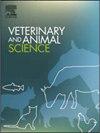Effect of vaccine diluents on the colonization of Salmonella Typhimurium vaccine in chickens
IF 1.9
Q2 AGRICULTURE, DAIRY & ANIMAL SCIENCE
引用次数: 0
Abstract
One of the commonly used methods to control on-farm Salmonella outbreaks in the poultry industry is vaccination. Vaccine diluents may affect vaccine efficacy but there are limited studies on how different diluents affect the colonization of live, attenuated vaccines. In this study, buffered peptone water, Marek's diluent and water were used as the diluents to reconstitute the commercially available Salmonella Typhimurium vaccine (Vaxsafe® ST). The diluent reconstituted vaccine was then given to day-old layer hens to test its effects on gut colonization. The vaccine reconstituted in Marek's diluent and buffered peptone water had a significantly higher colonization rate at 7 days post-vaccination in liver, spleen, oesophagus, crop, and proventriculus. At 14 days post-vaccination, there was a significantly higher vaccine load in the upper digestive tract of chickens that received vaccine reconstituted in Marek's diluent and buffered peptone water. The Marek's diluent and buffered peptone water reconstituted vaccine had a higher detection rate in the chicken's liver and spleen. Colonisation with water as a diluent was higher than the others especially in the lower parts of the intestine at 7 days post-vaccination. There was non-significant variation in the antibody titers at 7- and 14-days post-vaccination. In general, the results demonstrated that the use of nutrient-rich diluents in reconstituting live, attenuated Salmonella vaccine can enhance vaccine colonization. This study establishes a foundation for future work aimed at optimising strategies for vaccine reconstitution, crucial for eliciting a robust immune response in the host.

疫苗稀释剂对鸡伤寒沙门氏菌疫苗定植的影响
家禽业控制农场沙门氏菌爆发的常用方法之一是接种疫苗。疫苗稀释剂可能会影响疫苗效果,但关于不同稀释剂如何影响减毒活疫苗定植的研究却很有限。本研究使用缓冲蛋白胨水、马氏稀释剂和水作为稀释剂,重组市售的鼠伤寒沙门氏菌疫苗(Vaxsafe® ST)。然后将稀释液重组疫苗注射给日龄蛋鸡,以测试其对肠道定植的影响。接种后 7 天,用马立克氏稀释液和缓冲蛋白胨水重组的疫苗在肝、脾、食道、嗉囊和胃窦的定植率明显较高。接种后 14 天,接种马雷克氏稀释液和缓冲蛋白胨水重组疫苗的鸡上消化道中的疫苗载量明显较高。马立克氏稀释液和缓冲蛋白胨水重组疫苗在鸡的肝脏和脾脏中的检出率更高。在接种疫苗后 7 天,水作为稀释剂的定植率高于其他稀释剂,尤其是在肠道下部。接种后 7 天和 14 天的抗体滴度差异不大。总之,研究结果表明,在重组沙门氏菌减毒活疫苗时使用营养丰富的稀释剂可提高疫苗的定植率。这项研究为今后旨在优化疫苗重组策略的工作奠定了基础,而重组策略对于在宿主体内激发强有力的免疫反应至关重要。
本文章由计算机程序翻译,如有差异,请以英文原文为准。
求助全文
约1分钟内获得全文
求助全文
来源期刊

Veterinary and Animal Science
Veterinary-Veterinary (all)
CiteScore
3.50
自引率
0.00%
发文量
43
审稿时长
47 days
 求助内容:
求助内容: 应助结果提醒方式:
应助结果提醒方式:


